Last Updated on January 13, 2024 by Greg Gillson
Did you see a brightly-colored red bird, orange bird, or yellow bird in Illinois and wonder what is was?
This page is for you!
This article shows you photos and identification of some of the most common birds in Illinois based on color.
The list of birds found in Illinois includes over 440 species. So, I can’t show you all of them. I’m going to assume that you saw a common bird of this color, but you certainly could have seen something less common, or even rare!
Shape (including the shape of the bill) and size are often more helpful in starting to identify a bird than the color. In fact, most birds in North American can be easily identified with a black-and-white photo!
Many birds are multi-colored, so that it may be hard to pick out a dominant color. Males and females may be colored quite differently. And some color patterns are similar among otherwise dissimilar species.
Nevertheless, I’m going to try to pick out some of the birds that you are most likely to see in backyards or towns. And I’ll show a few others that I get asked about a lot.
The birds with a noticeable amount of red on them in Illinois covered in this article are:
- American Robin
- Northern Cardinal
- House Finch
- Ruby-throated Hummingbird
- Rose-breasted Grosbeak
- Red-headed Woodpecker
- Scarlet Tanager
- Ruddy Duck
- Summer Tanager
The birds with a noticeable amount of orange on them in Illinois covered in this article are:
- Barn Swallow
- Baltimore Oriole
- Eastern Towhee
- Brown Thrasher
- American Redstart
- American Kestrel
- Red-breasted Nuthatch
- Wood Thrush
- Orchard Oriole
The birds with a noticeable amount of yellow on them, including lots of yellow and black birds, in Illinois covered in this article are:
- American Goldfinch
- Northern Flicker
- Common Yellowthroat
- Yellow-rumped Warbler
- Cedar Waxwing
- Yellow Warbler
- Eastern Meadowlark
- Great Crested Flycatcher
- Magnolia Warbler
- Nashville Warbler
- Pine Siskin
- Yellow-throated Vireo
- Yellow-breasted Chat
Red birds of Illinois
Birds get the red, orange, and yellow in their feathers from carotenoids in the fruit, seeds, and plants they eat (source).
These carotenoid colors combine with melanin to form an infinite range of red feathers–pink, rusty, scarlet, violet, red-orange.
The following are red birds that you are most likely to see in Illinois.
American Robin
These are familiar lawn birds with red breasts.
 |
| American Robin. Greg Gillson. |
Male American Robins are brownish-gray above with a brick red breast. Females are paler orange below and paler gray above.
They are widespread in open country with scattered deciduous trees, residential areas.
American Robins are year-round residents throughout Illinois.
Northern Cardinal
These are one of the most common backyard birds in the eastern United States. Their bright red color and unique head profile makes them instantly identifiable to most people–whether they are bird watchers or not!
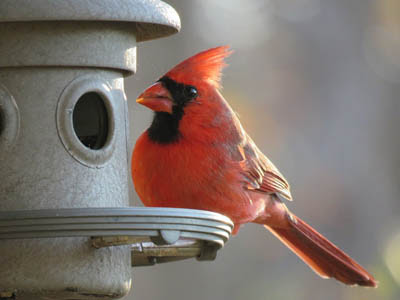 |
| Northern Cardinal. GeorgeB2 from Pixabay. |
Males of these large seed eaters are bright red with a black face and red crest.
Females replace most of the red with brown, The bill is large and orange.
These birds are found in woodlands, stream edges, residential areas.
Northern Cardinals are year-round residents throughout Illinois.
House Finch
When people ask about a bird with a red head at their feeder, it is usually this bird.
 |
| Male House Finch. Greg Gillson. |
Males of this dusty brown striped finch have red limited to the head (specifically the forehead and eyebrow), breast (chest), and rump. The red coloration tends toward orangish, and may rarely be yellowish.
Females are streaked, similar to the males but without red. They lack any strong pattern on the face and head.
Note the small round head and curved upper ridge on the bill.
Some people call these red-headed sparrows. Sparrows and finches are similar, but in general, male finches are brighter than the females and tend to hang out more in trees. Sparrow genders are usually quite similar in coloration and tend to feed mostly on the ground.
These birds are common in residential areas, especially at bird feeders. In the West more widespread in arid regions near water.
House Finches are year-round residents throughout Illinois.
Ruby-throated Hummingbird
These red-throated birds are the only hummingbird nesting in the eastern United States.

Males are dark green above and on the belly. They have a white upper chest. The throat is ruby-red.
Females are green above, white below, including white throat.
These birds are found in woodland edges, residential yards. Readily come to hummingbird feeders.
Ruby-throated Hummingbirds are summer residents throughout Illinois.
Rose-breasted Grosbeak
These birds with the red breast and huge pink bill sing beautiful robin-like songs from the tops of trees.
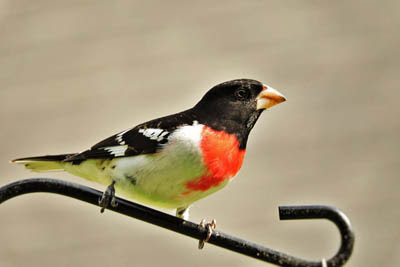 |
| Male Rose-breasted Grosbeak. Susan Killian. Pixabay. |
Males have black hood and upper parts. White under parts. Large white wing patches. Huge pink bill. Inverted bright red triangle on the breast.
Females are brown above, face with broad stripes, white throat. The under parts are buff with many thin brown streaks. Pale bill.
These birds inhabit deciduous and mixed forests. Shade trees in town. Come to feeders.
Rose-breasted Grosbeaks are summer residents throughout most of Illinois, spring and fall migrants only in southern Illinois.
Red-headed Woodpecker
These well-known woodpeckers with red heads have a fitting name.
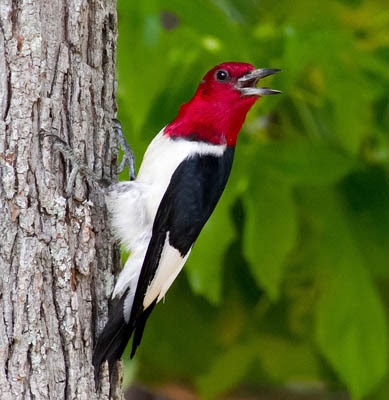 |
| Red-headed Woodpecker. Public domain. |
These birds have the entire head bright deep red. Back and tail black. Underparts white, as are inner secondaries and rump.
They are found in a variety of wooded habitats. They prefer to have oak and beech trees available. Sometimes come to feeders in winter.
Red-headed Woodpeckers are year-round residents throughout Illinois.
Scarlet Tanager
A brilliant red and black bird!
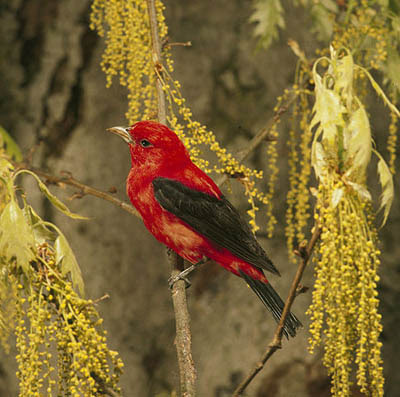 |
| Male Scarlet Tanager. USF&WS. Public Domain. |
Males are unmistakable with brilliant red with black wings and tail.
Females are olive-green above, darker wings and tail, yellower under parts. Pale bill.
These birds live in deciduous woods.
Scarlet Tanagers are summer residents throughout Illinois.
Ruddy Duck
These small ducks are dark rusty-orange in spring.
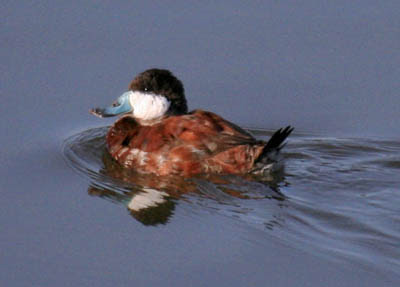 |
| Ruddy Duck. Greg Gillson. |
Males in breeding plumage (late winter and spring) are rusty, with a white face, and a blue bill. The long tail is often held sticking up. In winter they are brown, with white face, and dark bill.
Females all year are like winter males. Brown body, dark cap, dark line through eye of pale face. Dark bill.
These birds prefer weedy ponds to breed, but in winter may be found in deeper ponds in city parks.
Ruddy Ducks are winter visitors throughout Illinois.
Summer Tanager
These bright red birds are found toward the tops of tall trees in the southern United States.
 |
| Summer Tanager. Greg Gillson. |
Males are rose red with fairly heavy bill.
Females are yellowish or mustard-colored, some with a faint reddish wash.
In the East these birds are found in pine-oak woodlands. In the West they prefer tall cottonwood trees.
Summer Tanagers are summer residents throughout most of Illinois, absent in northeastern part of state.
Orange birds of Illinois
True orange-colored birds are not that common. Many birds that I have here are paler rusty.
The common pattern is an orange body and black or brown wings and tail. Another common pattern is for the orange to be restricted to the under parts.
The following are orange birds that you are most likely to see in Illinois.
Barn Swallow
These orange-bellied birds are a familiar sight across North America in summer.
 |
| Barn Swallow. Greg Gillson. |
These birds are purple-blue above with orange under parts and long forked tails. The color of the underparts in winter or on females are often cinnamon or buff-colored, but breeding males can be brighter orange-red.
These birds swoop low over fields and wetlands at lower elevations. They may build their mud nests in rafters on porches, garages, or other out-buildings.
Barn Swallows are summer residents throughout Illinois.
Baltimore Oriole
These bright orange and black birds are fairly common breeders in wooded areas in the East.
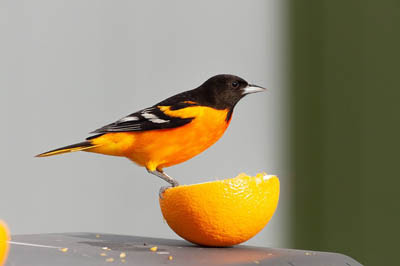 |
| Baltimore Oriole. Michael McGough. Pixabay. |
Males are have a black hood and back. Wings black with white patches. Tail black with orange sides to the base. Bright orange under parts.
Females are similar to males, but more olive above, less black. Immature birds for their first year or more are olive above orangish-yellow on the breast, fading to yellow on the belly. Two white wing bars.
These birds are common in deciduous woods, shade trees.
Baltimore Orioles are summer residents throughout Illinois.
Eastern Towhee
These birds with rusty-orange sides like to hide in dense bushes.
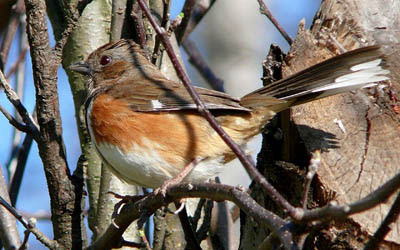 |
| Female Eastern Towhee. Skeeze. Pixabay. |
Males are black above with white wing patch, white tail corners. The sides are rusty. The belly white. Eyes variable: brown, red, orange, white, tending toward whiter southward.
Females are similar, but upper parts brown.
These birds are found in forest understory, dense brush, backyard hedges. Come to feeders.
Eastern Towhees are summer residents throughout Illinois, year-round residents in southeastern Illinois.
Brown Thrasher
These are rather large rusty-orange songbirds.
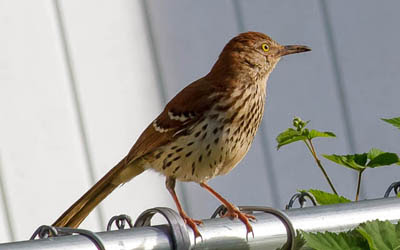 |
| Brown Thrasher. Linda Jones CC0. |
The upper parts of these birds is colored rusty-brown to orange. They show two white wing bars. Under parts are buff with heavy reddish-brown streaking.
These birds live in woodland edges and mature backyard landscaping.
Brown Thrashers are summer residents throughout Illinois, year-round residents in southern Illinois.
American Redstart
In flight these small warblers flash orange or yellow in the wing and based of the tail.
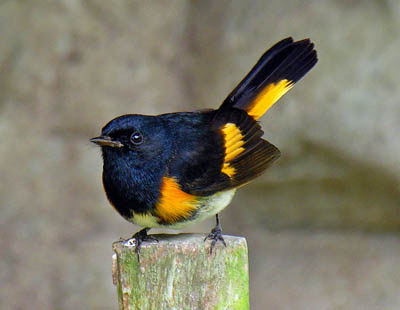 |
| American Redstart. Dennis Jarvis. Flikr. CC BY-SA 2.0 |
Males are black above, white on the belly. They have bright orange patches on side of breast, wings, and base of the tail.
Females are grayer, especially on the head. The orange of males is replaced by yellow on the females.
These birds are found in regenerating woods after a clear cut, and willow tangles along streams.
American Redstarts are summer residents throughout Illinois.
American Kestrel
These are the familiar small rusty-orange falcons sitting on power lines on the edge of the highway, or hunting and hovering over the median strip.
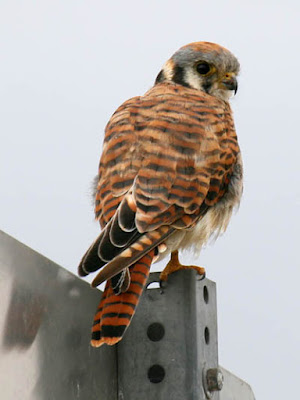 |
| Female American Kestrel. Greg Gillson. |
Females are rusty orange barred with black on their back wings and tail. The under parts are buff with black spots. The head shows two facial stripes.
Males have blue-gray backs and rufous tail is unmarked except for black tail band.
These birds are found in open country, farms, pastures with perches.
American Kestrels are year-round residents throughout Illinois.
Red-breasted Nuthatch
These active little red-breasted birds crawls all around on the trunk and big branches of conifers. They search crevices in the bark for insect food.
 |
| Red-breasted Nuthatch. Greg Gillson. |
These tiny birds have blue-gray backs and a black line through a white face. Some males can have quite bright rusty red under parts. Some females can have quite pale buff-colored under parts. Most birds show an orange-cinnamon breast color.
Found nearly exclusively in conifers. Readily come to feeders.
Red-breasted Nuthatches are winter visitors throughout Illinois.
Wood Thrush
These spotted birds with the orange-brown upper parts tend to hide in understory trees and on the forest floor.
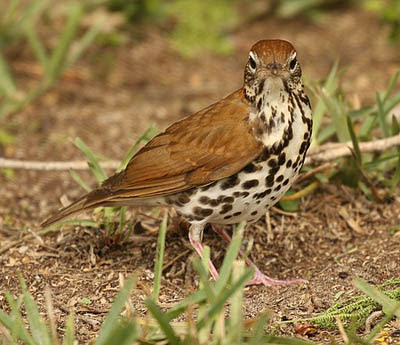 |
| Wood Thrush. Tony Castro. CC BY-SA 4.0 |
These birds are reddish brown on the upper parts, especially rusty orange on the crown and upper back. White eye ring. Large heavy black spots on the under parts.
They live in deciduous and mixed woods. Spend much time on the ground, shuffling through the leaf litter.
Wood Thrushes are summer residents throughout Illinois.
Orchard Oriole
Males of these orioles are darker rustier-orange than most other orioles in the United States.
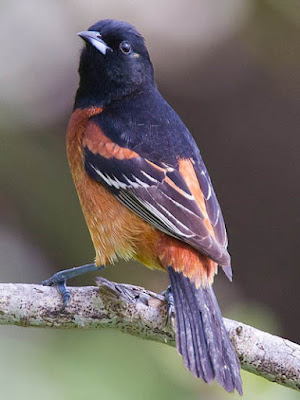 |
| Orchard Oriole. Dan Pancamo. Flikr. CC BY-SA 2.0 |
Males have a black hood and back, black wings and tail. The under parts are rusty-orange or even chestnut-brown.
Females are greenish above, lemon yellow below. They have 2 thin white wing bars. The bill is thinner than many other orioles.
They are found in orchards and residential shade trees.
Orchard Orioles are summer residents throughout Illinois.
Yellow birds of Illinois
Yellow is a common bird color! Often it is mixed with black and white plumage in birds.
Many birds with darker upper parts have yellow breast or belly.
The following are yellow birds you are most likely to see in Illinois.
American Goldfinch
These small little birds are bright yellow and black.
 |
| American Goldfinch. Greg Gillson. |
Males are bright lemon yellow with black and white wings and tail, black cap. White under tail coverts. Pink bill.
Females are duller yellow below and brownish above. Lack black cap.
Winter birds are pale brown or gray, a touch of yellow on the throat of males.
These are birds of open country, fields with saplings, clear cuts, residential areas. They avoid dense forests, mountains, deserts. They visit feeders.
American Goldfinches are year-round residents throughout Illinois.
Northern Flicker
These woodpeckers spend much time eating ants on the ground.
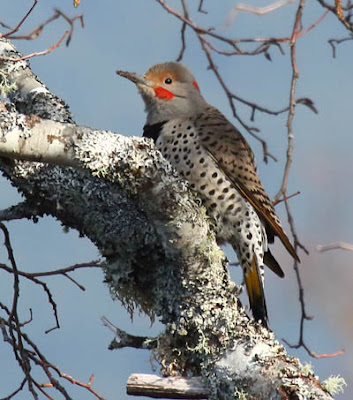 |
| Northern Flicker. Greg Gillson. |
These birds are larger than robins with brown and black barred upper parts. The underparts are pink with round black spots. There is a black crescent across the chest. When they fly away from you they reveal a large white rump.
Western birds have salmon-red under wings and under tail. Those in the East are colored yellow. The male face differs between the two populations–black whisker on the eastern birds, red whisker on western birds. Intergrades from overlap on Great Plains common. These may show male facial characteristics of both populations, or yellow-orange flight feathers.
These birds live in open woods with bare ground for foraging, residential yards.
Northern Flickers are year-round residents throughout Illinois.
Common Yellowthroat
These buttery yellow birds are abundant in the marsh vegetation.
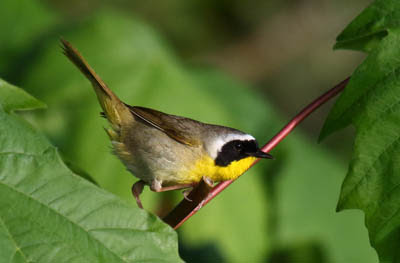 |
| Male Common Yellowthroat. Greg Gillson. |
These skulkers have bright yellow throats and yellow undertail coverts. Males have a black domino mask edged broadly in white, which females lack. Upperparts are dull olive-green.
Immature males in fall show a shadowed black mask.
Found in damp situations and heavy deciduous brambles following clear cuts.
Common Yellowthroats are summer residents throughout Illinois.
Yellow-rumped Warbler
These are abundant warblers across North America. Affectionately called “butter butts” by many birders, because of their bright yellow rumps that flash in flight.
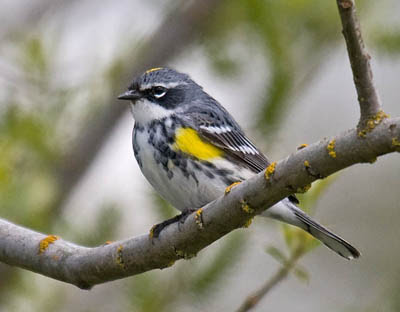 |
| Breeding Yellow-rumped (Myrtle) Warbler. Greg Gillson. |
Western form (Audubon’s) with bright yellow throat and yellow rump. Large white wing patch.
Northern and Eastern form (Myrtle) with white throat, yellow rump, and two white wing bars.
Winter birds are dull gray brown, with bright yellow rump. Throat may be cream colored or white. Often difficult to tell the two forms apart in winter.
 |
| Winter Yellow-rumped Warbler. Greg Gillson. |
Breed in mountain or boreal conifers. Widespread in migration. Winter in low river bottoms, open weedy deciduous areas. Rarely come to feeders in winter.
Yellow-rumped Warblers are winter visitors throughout Illinois, more common in the southern part of the state.
Cedar Waxwing
These crested birds with yellow band on the end of the tail are often found in flocks. They eat flying insects in summer, fruit and berries the rest of the year.
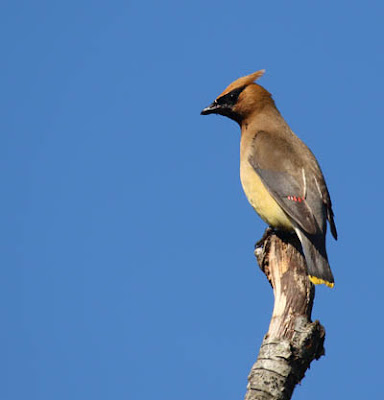 |
| Cedar Waxwing. Greg Gillson. |
These birds are fawn-brown above, with dark gray wings and tail. They have a black mask and wispy crest. The belly is yellow. The wings have waxy red drops on the end of the tertials. The end of the tail has a brilliant yellow tail band.
They are found in open habitats with berries, including juniper woodlands and towns in winter.
Cedar Waxwings are year-round residents throughout Illinois.
Yellow Warbler
The golden yellow sun packed all into one little bird! Appears to be an all-yellow bird.
 |
| Yellow Warbler. Greg Gillson. |
Some populations are bright yellow, some tend toward greenish on upper parts, some more golden. Yellow internal tail corners in flight.
Males with red breast streaking, again, variable by population.
Females somewhat to much paler yellow, some greenish, some whitish. Lack red streaks.
These birds are found in willow thickets on the edge of wetlands and ditches, stream sides in arid regions.
Yellow Warblers are summer residents throughout Illinois.
Eastern Meadowlark
These pale brown birds with the brilliant yellow breasts are home on the ground in prairies. They sing from perches on isolated trees, power poles, fence posts.
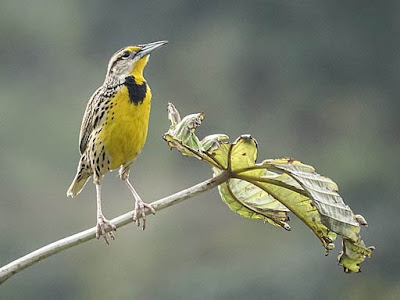 |
|
Eastern Meadowlark
Photo by Mike’s Birds from Riverside, CA, US [CC BY-SA 2.0]
|
The upper parts are streaked black, white, brown, so they blend into the dried grass where they live. The under parts are bright yellow with a black necklace across the chest. Very similar to Western Meadowlark, best told apart by spring song.
These birds live in prairies and extensive pasture lands.
Eastern Meadowlarks are year-round residents throughout Illinois.
Great Crested Flycatcher
These flycatchers have long tails and big heads with big bill and bright yellow belly.
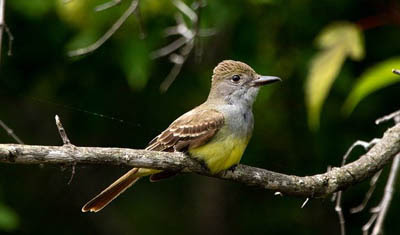 |
| Great Crested Flycatcher. Simard Francois. Pixabay. |
These birds are gray on the face and breast, brownish on rest of upper parts. Bright lemon yellow belly. The under side of the tail and some feathers of the wing are cinnamon colored.
These birds stay in the canopy of open woods.
Great Crested Flycatchers are summer residents throughout Illinois.
Magnolia Warbler
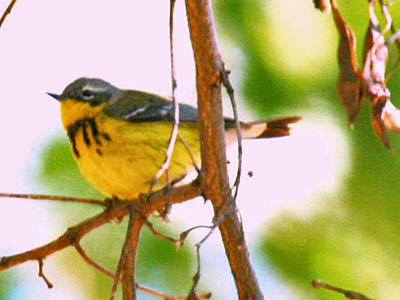 |
| Magnolia Warbler. Greg Gillson. |
Adult males are gray and black above and bright yellow below. Black mask and lower face. Gray crown. Black upper back. Black necklace that breaks into streaks down the breast. White under tail coverts. White under tail base, black terminal tail feathers. Large white wing patch.
Female with two wing bars, black mostly replaced with olive. Immatures for the first year lack black markings.
Live in moist coniferous forests, young stands of spruce and hemlock.
Magnolia Warblers are spring and fall migrants throughout Illinois.
Nashville Warbler
These birds with the bright yellow underparts do a good job of hiding!
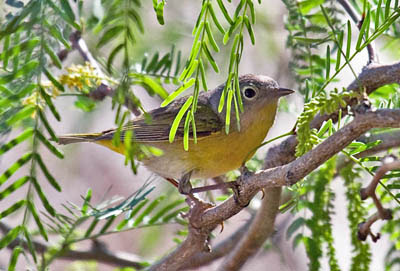 |
| Nashville Warbler. Greg Gillson. |
These birds are gray above. The throat and breast and under tail coverts are bright lemon yellow. The belly is white. They have a complete white eye ring.
Females are just a bit paler than males.
These birds are found in re-growing clear cuts, and understory brush in open woods.
Nashville Warblers are spring and fall migrants throughout Illinois.
Pine Siskin
These small brown-streaked birds are relatives of the goldfinches. But you would never know it until they fly and sport yellow wing stripes and tail base. Usually in flocks.
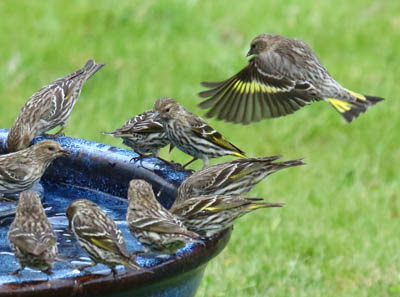 |
| Pine Siskin. Greg Gillson. |
These birds are streaked brown. In flight they have a yellow stripe down the length of the wing. The sides of the base of the tail is also yellow. Some birds are paler, some darker, others brighter yellow, others duller.
These birds are found in summer in northern conifer woods. Irregularly irrupt hundreds of miles southward. Frequent at feeders.
Pine Siskins are winter visitors throughout Illinois.
Yellow-throated Vireo
Vireos are slow moving small birds that sing throughout the day. These yellow-headed vireos are one of the most colorful of their clan.
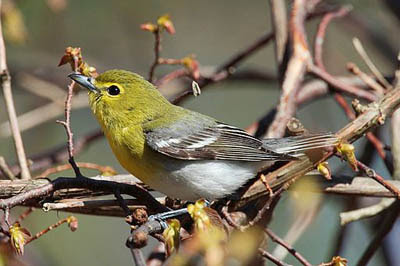 |
| Yellow-throated Vireo. MDF. CC BY-SA 3.0 |
These birds are blue-gray above, white below. Two white wing bars. Their head is olive yellow with yellow spectacles around the eye, and bright yellow throat.
These birds like large tracts of unbroken deciduous or mixed woodlands. Interestingly, however, they are often found on forest edges.
Yellow-throated Vireos are summer residents throughout Illinois.
Yellow-breasted Chat
These unique larger yellow birds may sing day and night, and include whistles and crow-like cawing, often given in a display flight.
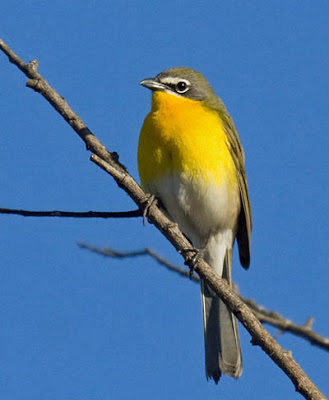 |
| Yellow-breasted Chat. Greg Gillson. |
These birds are greenish above with bright yellow breast and white belly. They have a dark mask bordered with white.
These birds live in tangles and wet woods.
Yellow-breasted Chats are summer residents throughout Illinois.
Wrapping Up
Illinois boasts a vibrant array of colorful birds, adding splashes of avian beauty to its diverse landscapes. Here are some of the most dazzling feathered friends you might encounter further afield from your backyard in the Prairie State:
Summer Beauties:
- Cardinal: The Illinois state bird, the Northern Cardinal, steals the show with its fiery male plumage of red breast, black mask, and crest. Look for them in forests, backyards, and shrublands.
- Indigo Bunting: During breeding season (April-September), males transform into living sapphires, showcasing a deep blue body with a black head and bib. Find them in open fields, grasslands, and shrubby areas.
- American Goldfinch: These tiny marvels sport sunshine on wings during breeding season, with bright yellow bodies, black caps, and black wing bars. You’ll see them flitting through fields, meadows, and gardens.
- Baltimore Oriole: This orange and black masterpiece arrives in spring, dazzling with its intricate woven nest and sweet, whistling song. Look for them in open woodlands, parks, and backyards with tall trees.
Year-round Charmers:
- Blue Jay: These bold and vocal birds flash their stunning combination of blue, black, and white through forests and woodlands. Keep an eye out for their acrobatic displays and loud calls.
- Eastern Bluebird: These sky-blue beauties with rusty orange breasts add a touch of elegance to parks, orchards, and open woodlands. Their melodious songs are a delight to hear.
- Downy Woodpecker: Small but vibrant, these black and white woodpeckers drum on trees and sport a bright red patch on the nape of their neck. You’ll find them in various wooded habitats.
- Black-capped Chickadee: Energetic and inquisitive, these little gray birds with a black cap and bib readily visit feeders and flit through trees, adding a touch of cheer to any landscape.
Frequently Asked Questions
What is the black and orange bird in Illinois?
The Baltimore Oriole, with its stunning orange and black plumage, is a captivating songbird beloved across North America. But beyond its beauty, this feathered charmer hides some fascinating facts that will make you appreciate them even more:
Master Architects:
- Hanging Masterpieces: Their woven nests, suspended from branches like upside-down baskets, are marvels of avian engineering. Using materials like bark, grass, and even string, they create sturdy, intricately woven structures that can last for years.
- Sneaky Recyclers: Orioles often reuse their nests, adding new materials and strengthening them each season. They’ve even been known to incorporate discarded yarn or string into their creations!
Sweet Tooth with a Bite:
- Orange Obsession: These birds aren’t just colorful, they also have a serious sweet tooth! They readily devour orange slices and grape jelly, even visiting feeders specifically for these sugary treats.
- Insect Aficionados: But don’t be fooled by their sweet side. Orioles are primarily insect eaters, playing a vital role in controlling pest populations like caterpillars and beetles. They hunt skillfully, snatching insects mid-air or gleaning them from leaves.
Musical Virtuosos:
- Whistling Wonders: The Baltimore Oriole’s song is a complex and beautiful symphony of whistles, warbles, and flutters. Males use this impressive repertoire to attract mates and defend their territory.
- Mimic Masters: Not only do they have their own song, but Orioles are also skilled mimics. They can incorporate sounds from other birds, frogs, and even car alarms into their vocal performances!
More Surprises:
- Changing Feathers: Young male Orioles don’t acquire their vibrant orange plumage until their second year. They spend their first summer sporting a duller, female-like appearance.
- Symbiotic Relationships: Orioles sometimes benefit from the defensive behavior of larger birds like crows and jays. The presence of these aggressive birds can deter smaller predators, creating a safer environment for Orioles to nest and raise their young.
What kind of bird is brown with a red head in Illinois?
There are several possibilities for a brown bird with a red head in Illinois, depending on additional details like size, habitat, and time of year. Here are some likely candidates:
- House Finch: Males showcase a brown streaked body with a bright red chest and head during breeding season. They frequent backyards, feeders, and open areas.
- American Robin: While the male robin displays a rusty red breast, females and juveniles can appear more brownish with a faint reddish tinge on the head, especially during breeding season. Look for them in lawns, parks, and woodlands.
- Red-headed Woodpecker: This striking bird boasts a completely red head, black back, and white underparts. Look for them in open woodlands, parks, and even backyards where they drum on trees.
What kind of yellow bird has black wings in Chicago?
Several yellow birds with black wings might be seen in Chicago, depending on the timing and details of your observation. Here are some likely candidates:
- American Goldfinch: This tiny songbird is a common sight in urban and suburban areas during breeding season. Males boast a vibrant yellow body, black wings with white bars, and a black cap. You’ll see them flitting in fields, meadows, and even backyards.
- Baltimore Oriole: This striking orange and black bird with prominent black wings arrives in spring and frequents open woodlands, parks, and backyards with tall trees. Males have a beautiful whistling song.
- Yellow Warbler: These small, active warblers have a greenish-yellow back, yellow throat and breast, and black wings with white bars. They prefer dense vegetation in forests and parks during breeding season.
- Pine Siskin: These flocking birds have a streaked yellow body, black wings with white bars, and a yellow rump. Look for them in coniferous forests and at feeders, especially during winter.
Related Articles:
See photos and learn about the most common backyard birds in Illinois, regardless of color.
Find out what birds are at your feeder in Illinois
See photos and learn what to feed winter birds in Illinois.
Here’s a quick tutorial of how I would teach you to identify birds: 7 Steps to Identify Birds!
Birds with red heads in North America.
Yellow-and-black birds in North America.










